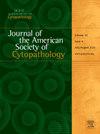转移性低her2乳腺癌的评估:增殖和生存的细胞学方法。
Q2 Medicine
Journal of the American Society of Cytopathology
Pub Date : 2025-01-06
DOI:10.1016/j.jasc.2025.01.001
引用次数: 0
摘要
人表皮生长因子受体2 (HER2)-低乳腺癌,定义为HER2免疫组化评分为1+或2+,无基因扩增,是一个独特的亚组,具有新兴的治疗意义。有限的数据描述了her2低肿瘤的行为,特别是在转移情况下。本研究利用细胞学标本评估了转移性乳腺癌中HER2低表达频率、Ki-67增殖指数和HER2亚型的生存结果。方法:对43例经细针穿刺或剥脱细胞学诊断为转移性乳腺癌的患者进行3年回顾性分析。免疫组织化学检测HER2、ER、PR和Ki-67状态,原位杂交评估模棱两可的HER2病例。使用Kaplan-Meier方法估计生存结果,并使用Cox回归确定生存预测因子。结果:43例患者中,her2低31例(70.5%),her2阳性6例(13.6%),her2零6例(13.6%)。原发性和转移性病变之间的HER2不一致发生率为19%,主要涉及向HER2低状态的转变。激素受体阳性在her2 -低肿瘤中(71%)比her2 -零肿瘤(33%)更常见(P结论:her2 -低表达在转移性乳腺癌中普遍存在,具有独特的激素受体谱。研究结果强调需要重新评估HER2在转移环境中的状态,具有潜在的治疗意义。本文章由计算机程序翻译,如有差异,请以英文原文为准。
Evaluation of HER2-Low breast carcinoma in metastatic settings: a cytological approach to proliferation and survival
Introduction
Human epidermal growth factor receptor 2 (HER2)-low breast cancer, defined by HER2 immunohistochemistry scores of 1+ or 2+ without gene amplification, represents a unique subgroup with emerging therapeutic implications. Limited data describe the behavior of HER2-low tumors, particularly in metastatic settings. This study evaluated the frequency of HER2-low expression, Ki-67 proliferation index, and survival outcomes across HER2 subtypes in metastatic breast carcinoma using cytology specimens.
Materials and methods
A 3-year retrospective analysis identified 43 patients with metastatic breast carcinoma diagnosed via fine-needle aspiration or exfoliative cytology. HER2, ER, PR, and Ki-67 status were determined by immunohistochemistry, with equivocal HER2 cases assessed by in situ hybridization. Survival outcomes were estimated using the Kaplan–Meier method, with Cox regression identifying predictors of survival.
Results
Among 43 cases, 31 (70.5%) were HER2-low, 6 (13.6%) HER2-positive, and 6 (13.6%) HER2-zero. HER2 discordance between primary and metastatic lesions occurred in 19%, mainly involving transitions to HER2-low status. Hormone receptor positivity was more frequent in HER2-low tumors (71%) than HER2-zero tumors (33%) (P < 0.001). Mean Ki-67 was highest in HER2-low (45%) versus HER2-negative (34%) and HER2-positive (33%) cases (P = 0.549). Median survival was 13 months for HER2-low and 5 months for HER2-negative patients; survival differences were not significant (P = 0.225). Younger age (HR = 0.240, P = 0.048) and hormone receptor positivity (HR = 0.273, P = 0.011) were significant predictors of survival.
Conclusion
HER2-low expression is prevalent in metastatic breast carcinoma with a unique hormone receptor profile. Findings highlight the need for reassessment of HER2 status in metastatic settings, with potential therapeutic implications.
求助全文
通过发布文献求助,成功后即可免费获取论文全文。
去求助
来源期刊

Journal of the American Society of Cytopathology
Medicine-Pathology and Forensic Medicine
CiteScore
4.30
自引率
0.00%
发文量
226
审稿时长
40 days
 求助内容:
求助内容: 应助结果提醒方式:
应助结果提醒方式:


